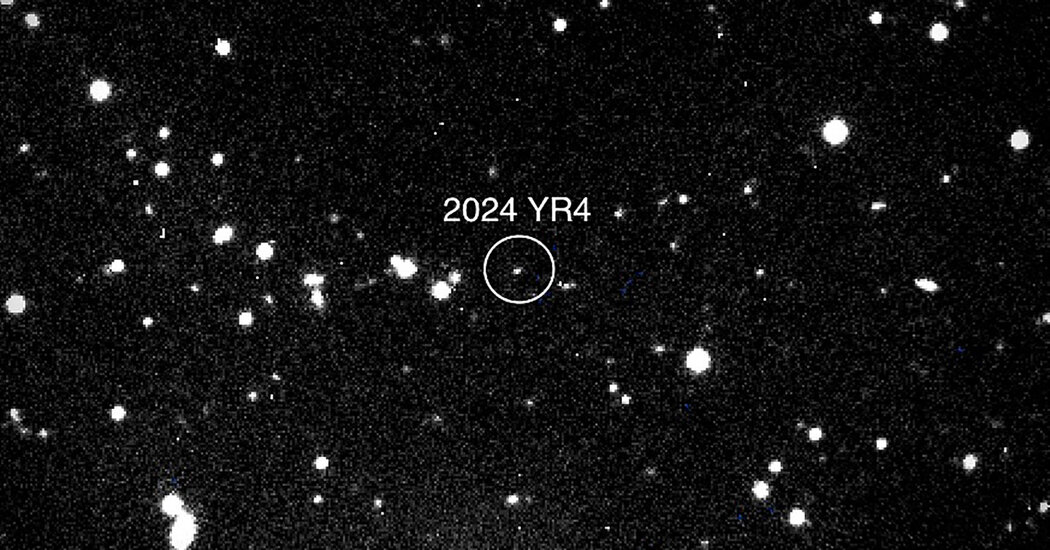Astronomers on Tuesday said that the asteroid designated 2024 YR4 had become the most likely sizable space rock ever forecast to impact planet Earth. The object, first detected in December, is 130 to 300 feet long and expected to make a very close pass of the planet in 2032. Its odds of impacting Earth on Dec. 22 of that year currently stand at 3.1 percent.
That exceeds the threat once posed by Apophis, a much larger asteroid that was discovered in 2004. Astronomers initially calculated its chances of hitting Earth in 2029 at 2.7 percent. Further observations of Apophis reduced the odds of an impact at any time during the next century to zero. But the prospect was, for a time, unsettling.
While 2024 YR4 is far smaller than Apophis, a diminutive asteroid is still capable of causing tremendous devastation. Much depends on where it would enter Earth’s atmosphere.
Although 2024 YR4 would not come close to decimating a country, it could scar or demolish a city with a direct hit. And there is a very slim chance that it might. Much of the object’s estimated track passes over empty ocean, but some possible impact locations are close to large cities like Bogotá, Lagos and Mumbai.
The kinetic energy of an asteroid is a proxy for how destructive its impact would be. And as asteroids mostly move at the same speed — about 38,000 miles per hour — the key variable is its mass.
With just a handful of observations to rely on, astronomers only have a range of estimates for the mass of 2024 YR4. “We don’t know how dense or porous it is, so its mass, and therefore the energy it would release if it strikes Earth’s surface or explodes in the atmosphere, is uncertain,” said Mark Boslough, a physicist at the Los Alamos National Laboratory.
In all cases, though, “the bigger it is, the worse it is,” said Gareth Collins, an asteroid impact expert at Imperial College London. And small increases in size translate to giant leaps in destructive potential. The rule of thumb is that if an asteroid’s radius doubles, it has eight times more kinetic energy; a 300-foot asteroid will do far more damage than a 130-foot one.
The composition is also important. An asteroid made mostly of iron, for instance, would plunge deeper into the atmosphere and deliver a more injurious punch to the planet. But 2024 YR4 is statistically likelier to be a stony asteroid, which is more prone to fragment into smaller pieces as it is heated during its atmospheric descent.
But even a midair immolation of an asteroid — an airburst — can be extremely fierce.
If 2024 YR4 is stony and on the smaller end of estimates — 130 feet — the odds of an airburst are high, said Kathryn Kumamoto, the head of the planetary defense program at the Lawrence Livermore National Laboratory.
“The main comparison point we have for a stony asteroid impact of this magnitude is Tunguska,” Dr. Kumamoto said. The Tunguska event of 1908 involved an asteroid similar in size to 2024 YR4 exploding above a sparsely populated part of Siberia. It generated a blast wave of roughly 12 megatons, not unlike that of a nuclear weapon, that destroyed a forest more than twice the size of New York City.
A 130-foot rock exploding above the open ocean, or even nearer shore, would not be particularly concerning, as it “would be unlikely to cause a significant tsunami,” said Lorien Wheeler, an expert at the Asteroid Threat Assessment Project at NASA’s Ames Research Center in California.
An airburst above a city would be more unpleasant. Windows would explode inward, producing shotgun sprays of glass, and the damage to buildings would be widespread. Some injuries could be life-threatening.
The angle at which the asteroid enters the atmosphere makes a difference. If it comes in straight down, it may come closer to the ground before exploding and potentially inflict more destruction. Entry at a more gradual angle may result in an explosion at a much higher altitude.
If 2024 YR4 turns out to be 300-feet long, its impact “could cause more severe damage,” said Michael Aftosmis, an expert at the Asteroid Threat Assessment Project.
Such an asteroid “is more likely to make it through the atmosphere, particularly if we are unlucky and the entry angle is steep,” said Dr. Kumamoto. “A portion could make it to Earth’s surface relatively intact.”
An impact in the remote ocean far from land would pose much less risk, said Dr. Kumamoto — tall waves that would quickly shrink before reaching land. A splashdown next to a coastline, however, could cause a tsunami capable of inundating nearby land.
Should this larger version of 2024 YR4 hit solid ground, it could carve out a crater perhaps two-thirds of a mile across.
“The asteroid would create an enormous explosion,” Dr. Boslough said. And the blast wave would be astonishingly powerful. Multistory buildings around the crater would buckle and crumple, bridges would fold over, and cars, trees and people would be thrown in all directions. Dr. Boslough also noted the potential for a “hot jet of asteroid vapor that would descend to the surface and incinerate everything.”
People close to ground zero would very likely die, he said. And people tens of miles away would still be hit by a thundering, expanding blast wave. “People within the local region would be at risk of serious injury,” Dr. Kumamoto said.
Experts said that it’s still unlikely that 2024 YR4 will impact Earth in 2032. But this range of impact outcomes is precisely why planetary defenders are taking this asteroid deadly seriously.


